2023 FALL
Elegy for a Glacier
A team of UP researchers is measuring Eliot Glacier on Mt. Hood. Understanding how fast it’s melting will help agriculture in the valley below prepare for the future.
- Story by Cheston Knapp
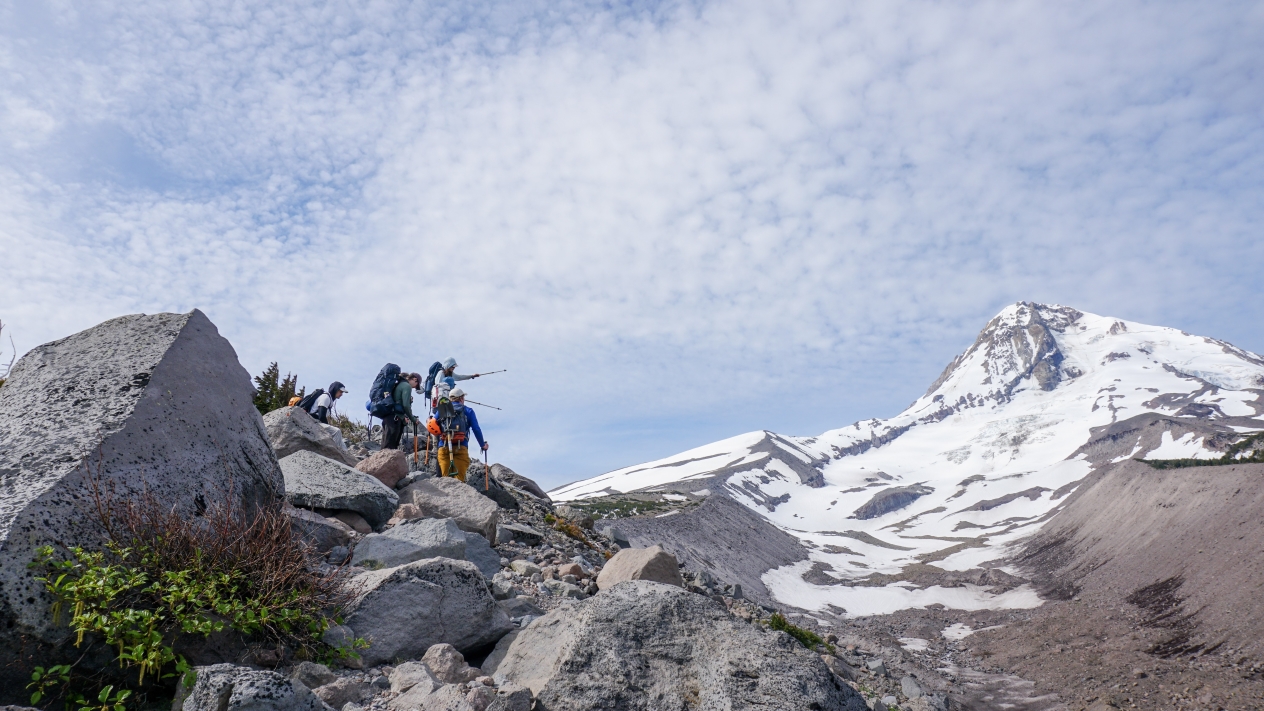
Photo by Rishi Chandra
IT’S 5:30 A.M. on a morning in early June and the minivan is heading east through the Columbia River Gorge. The landscape sliding by outside is one a toy train enthusiast might dream of miniaturizing. When we round a bend in the highway, Mount Hood briefly fills the windshield, glowing in this fragile dawn light. It’s still hard for me to believe that we’ll be up there later today, above the tree line in the cryosphere, where the research team I’ve barnacled myself to will begin assessing the health of Eliot Glacier, the mountain’s largest hunk of slow-poke ice.
At the helm of this expedition (and the van) is Kiya Riverman, PhD, assistant professor of environmental studies. Two of her students, Parker Wilkerson ’24 and Aidan Brennan ’25, sit behind us in the van, and we’re meeting a third, Hannah Ton ’24, up on the mountain. They were selected from a competitive pool of applicants to participate in this project about how climate change is affecting Eliot. Today is the first of five they’ll be spending on the mountain, taking extensive measurements in the field, and there’s a tinge of giddiness to the mood inside the van. Kiya seems especially jazzed—it’s like she’s heading back to where she belongs.
And there’s an obvious urgency to these questions. You’d have to have been living very far off the grid not to know that glaciers are disappearing at an alarming rate. According to one estimate, the Earth loses 400 billion tons of its glaciers per year. That’s an unconscionable amount of ice, as inconceivable as Deep Time. In 2019, the Greenland Ice Sheet lost more than ten billion tons in one day. Tonnage-wise, that’s like losing the populations of the two largest cities on Earth, Tokyo and Delhi, if every resident were a blue whale. Because their loss presents a feedback loop of problems, like sea-level rise, glaciers have become the poster child of the ongoing climate crisis. But unlike the glaciers themselves, glaciology is a growing field.
Kiya talks at length about her work up in Alaska, on the Juneau Icefield, and down in Antarctica, on Thwaites, the so-called Doomsday Glacier. These early-career accomplishments are the product of her tremendous passion and curiosity, traits that form the bedrock of her personality. It’s easy to imagine her as a child, with crescent-moons of dirt under her fingernails, parading a thunderegg around the house, rapt in wonder. As we head deeper into the Gorge, heeding Eliot’s call, it seems to be taking all of her not to buck against the wheel to urge the van to go faster.
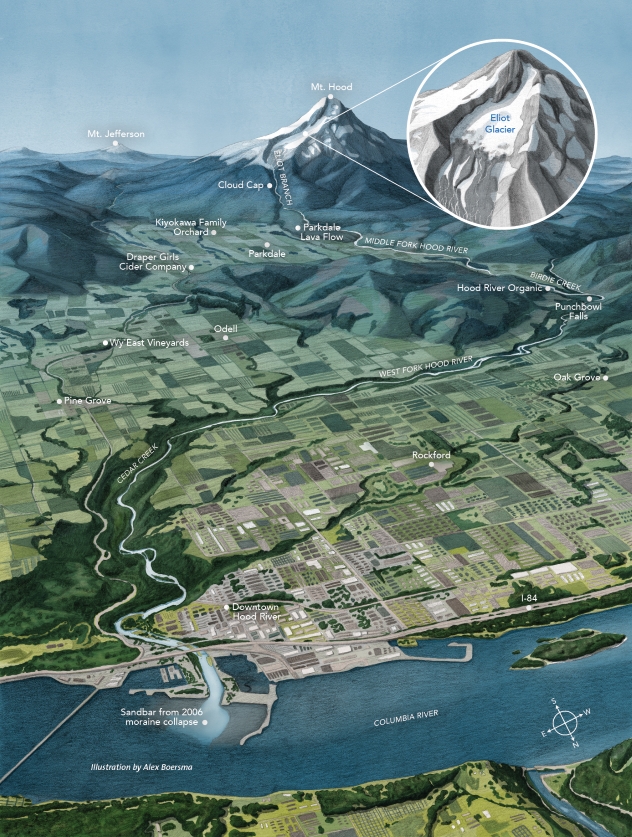
Illustration by Alex Boersma
FORTY MINUTES LATER we pull off I-84 at Hood River, where the welcome sign features an upended fruit basket, spilling over with apples, pears, and bunches of grapes. Mount Hood is now ever-present in the windshield, filling even more of it as we pass sprawling groves of fruit trees, trellised grapevines, and charming gabled barns. “Support Youth Agriculture,” reads one sign we pass, advertising the local 4H chapter. In the computer lab earlier this week, Hannah showed me a digital rendering of the watershed for this part of the Hood River Valley—it looked like the vasculature system of a creature shaped like a gumdrop, with rills and creeks branching off from streams and rivers, all of which flow down to the mighty Columbia.
“The agriculture here relies on water that comes off Eliot Glacier for irrigation,” she said. “It’s a multimillion-dollar industry.”
It’s such a boom time for ice science, in part, because we need to understand how melting glaciers will affect surrounding ecosystems and landscapes, including the one we’re driving through. As a scientist, Kiya aspires to be as descriptive and value-neutral as possible, but one of the big implicit questions undergirding this project is how long the Hood River Valley can expect to rely on Eliot’s glacial meltwater for irrigation and domestic use. As a benchmark, they’re using a study that was done more than fifteen years ago. By comparing the data they find against this earlier paper, they hope to determine how fast it’s melting and, therefore, to provide something of a grim ticking clock for its lifespan.
For the last few weeks, the team has been doing preliminary research on campus, calibrating the gear they’ll be using in the field and studying satellite images of Mount Hood. When I visited the computer lab, Aidan circled Eliot for me on an image from Google Earth. It flows down the mountain’s northeast side. When it was measured back in 2007, it covered more than half a square mile, which is about half of NYC’s Central Park. In some places it was nearly three-hundred feet thick.
I also gathered that, thanks to its host, Eliot is an unusual glacier. Hood is a stratovolcano with a relatively weak and friable headwall. Every so often it breaks, sending rocks tumbling down onto the glacier’s surface. Over time, after all those successive snowfalls, the glacier subsumes these rocks and ferries them down the mountain like fruit in a Jell-O mold. After this peristalsis, they’re expelled near the foot of the glacier, where it loses mass to melting. As a result, a layer of rock and debris up to seven feet deep blankets the ice, giving no indication that there’s glacier ice below.
“Glaciers are such an effective way to shape and carve the landscape,” Kiya says. We’re close enough now that Hood has disappeared behind the trees. “They’re a conveyer belt for rocks.”
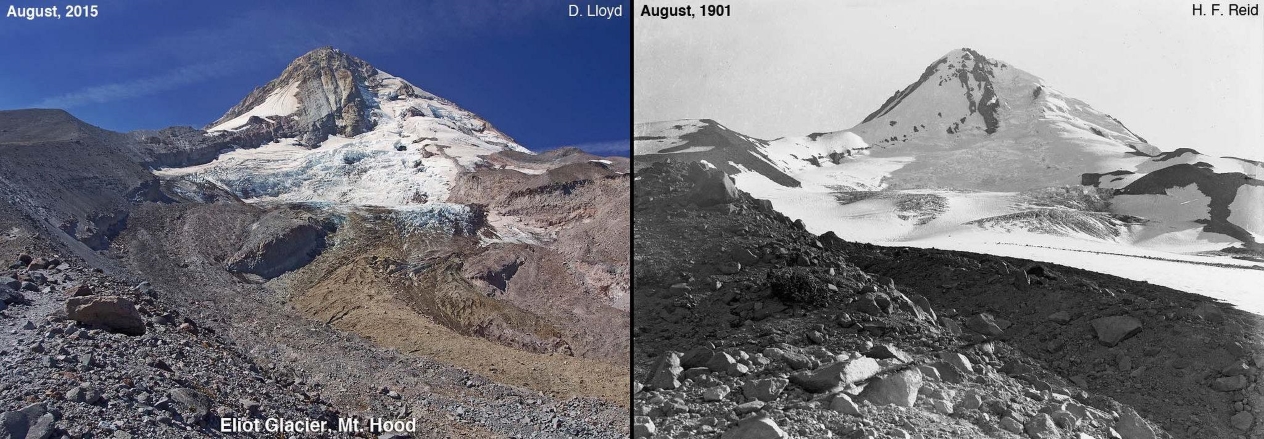
Loss of irrigation and bathwater isn’t the only consequence of Eliot’s melting, though. Receding glaciers present other risks, like the failure of the valley walls that are left behind retreating ice. These are called moraines. As the glaciers on Hood flowed for eons, they eroded the mountain’s volcanic rock and deposited the ground-up material along their edges. When they recede, they leave in their wake steep dunes of loosely-packed sediment, no longer shored up by ice. Imagine a half-pipe made of sand. And these unstable formations can fail, especially during heavy rains, creating massive and terrifying debris flows, i.e., land- and mudslides, that threaten areas below.
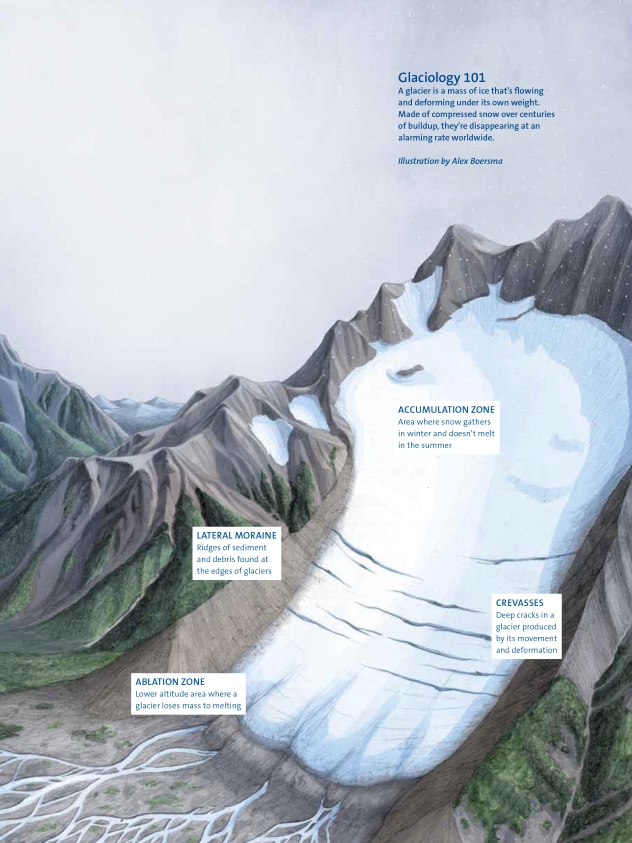
In November 2006, for example, a particularly heavy rainfall caused part of the Eliot moraine to collapse, and this created a monstrous debris flow that blanketed the forest and destroyed about twenty miles of the road we’re on, Highway 35. So much sediment was sent downstream that residents of Hood River woke up to a sandbar in the Columbia that hadn’t been there the day before. It’s still there; they officially christened it The Sandbar. Less dramatic flows can still cause issues, though, and farmers in the area have had to learn to deal with glacier sediment routinely gumming up their irrigation systems. All in all, the more we understand about the glaciers, the better prepared we’ll be to deal with the consequences of their disappearance.
KIYA STEERS US onto Cloud Cap Road, which snakes us up into the forest. The ambiance of these woods, full of mossy and Entish evergreens, oscillates between cozy and spooky—it seems home to capering fawns and ruthless Sasquatches alike. We soon come to a gate that bars our way forward, one a troll might guard. Cryospheric conditions like persistent snow and ice, as well as downed trees, keep the road beyond this point closed for much of the year. It won’t be open to the public until later this summer. But thanks to the considerable legwork Kiya has put in, we have the code.
In preparation for this trip, Kiya made arrangements with the Forest Service and The Crag Rats, the oldest search and rescue organization in the country. Comprised entirely of intrepid volunteers, they maintain the historic Cloud Cap Inn, which sits at an elevation of 6,000 feet and offers convenient access to Eliot Glacier. They use it as their headquarters for rescue operations, snow surveys, and as a clubhouse of sorts for group hangs, where I imagine they practice tying knots, drink fortifying grog, and whittle cool stuff. Typically an exclusive outfit, they’ve generously offered it up to Kiya and her team of students to use as homebase for their project. Instead of three nights bivouacked outdoors, they’ll have access to a kitchen, running water, and real beds, not to mention the added security of their expertise—a true boon. Ever the planner, Kiya also has one eye on the future and hopes this bit of generosity is just the beginning of a beautiful friendship.
“This project is bigger than we can tackle in one year,” she says. “It’d be great if we could keep it going.”
Beyond the gate the road has the consistency of a rumble strip and is flanked by fallen trees, including some that appear to have been freshly chainsawed. In August, you’ll be able to take this all the way up to the Inn, but deadfall finally gets too heavy and brings us to a halt near the Wagon Road Trail, roughly five miles from Cloud Cap.
A Crag Rat named Cully will be guiding us the rest of the way up and giving the team entrée to the Inn. He meets us at the trailhead with his dog. By day a surgeon, he has a cheery disposition and exudes a rugged savoir faire—it’s as easy to imagine him windsurfing as it is hauling an unfortunate climber out of a crevasse, and his presence calms my city-boy nerves. We all suit up and take to the trail. Aidan has drawn the short straw and has to shoulder a large plastic orange sled that they’ll use to drag the high-tech radar machine across the snow to measure the glacier’s depth—he looks particularly sherpa-like as he heads up before me.
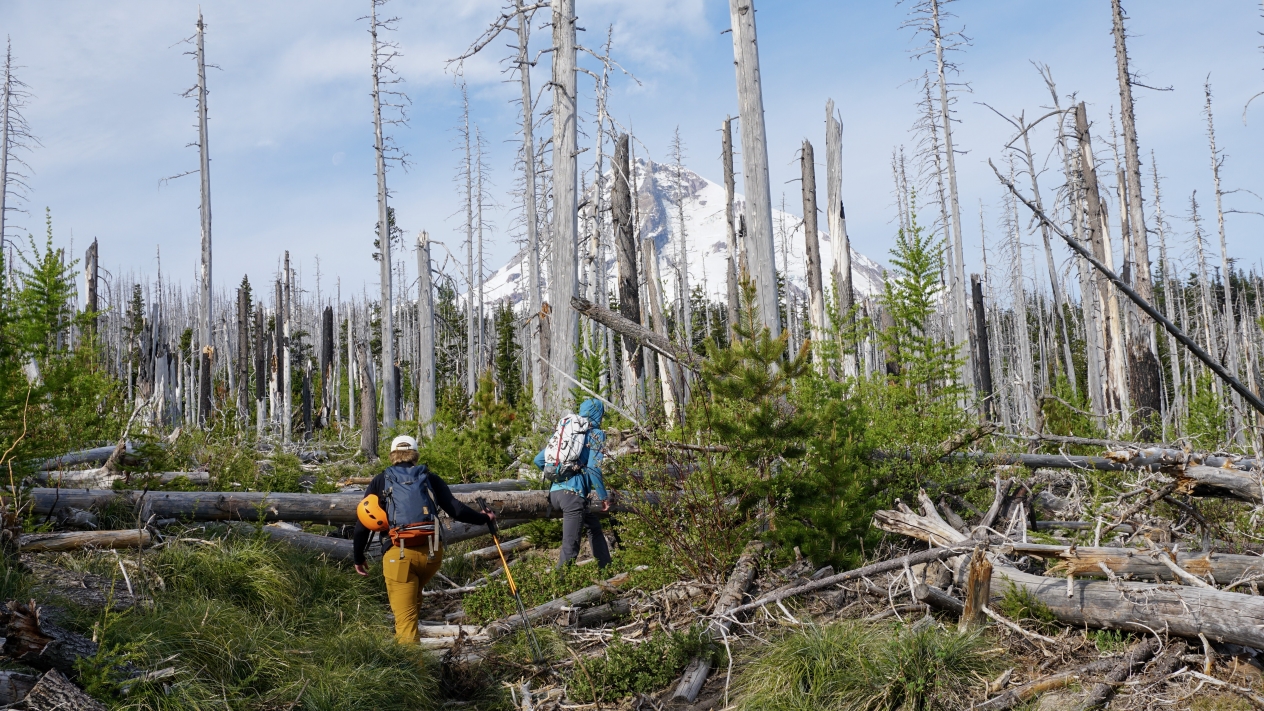
Photo by Rishi Chandra
“Trail” turns out to be a generous description of the route we’re following—it’s hidden under so many fallen trees that it looks like a game of fiddlesticks fit for colossi. We clamber over and duck under them. Naked, ashy-white tree trunks rise around us like devilish spears, evidence of the Gnarl Ridge fire that decimated the area back in ’08 and nearly engulfed the Inn. Old burned branches occasionally explode into bark chips underfoot and blackened trunks on the ground glister in the light. But life is tenacious and new saplings can be found sprouting up everywhere you look, tentative greetings from a greener future.
“I know not all of these students are going to become glaciologists,” Kiya says as we plod along. “But just being out here helps encourage them to be conservationists.”
She gestures expansively with her trekking poles, and I turn to take in the view. Across the Columbia, Mount Adams rises on the horizon, a mirror image of Hood. Way off in the distance to the north, you can just make out the ghostly and bulbous outline of Rainier, an impossible mirage. The valley below is a patchwork quilt of rich verdure, furry beiges, and dark russets. Every landscape tells a story if you know how to read it right—that’s the motif I keep hearing in everything Kiya says. And the spectacular one down in the Gorge is about the eruptions of basalt from long-dead volcanoes, the dramatic sinking of the Earth’s crust, and the cataclysmic Missoula floods. All these incredible and relentless forces performed a ragged surgery on the earth over vast tracts of time, leaving these scars that scientists like Kiya can decode. My laic eyes are so stimulated they practically hum at the sight.
“Can you believe we’re getting paid for this?” she asks, her voice aflutter with excitement and wonder.
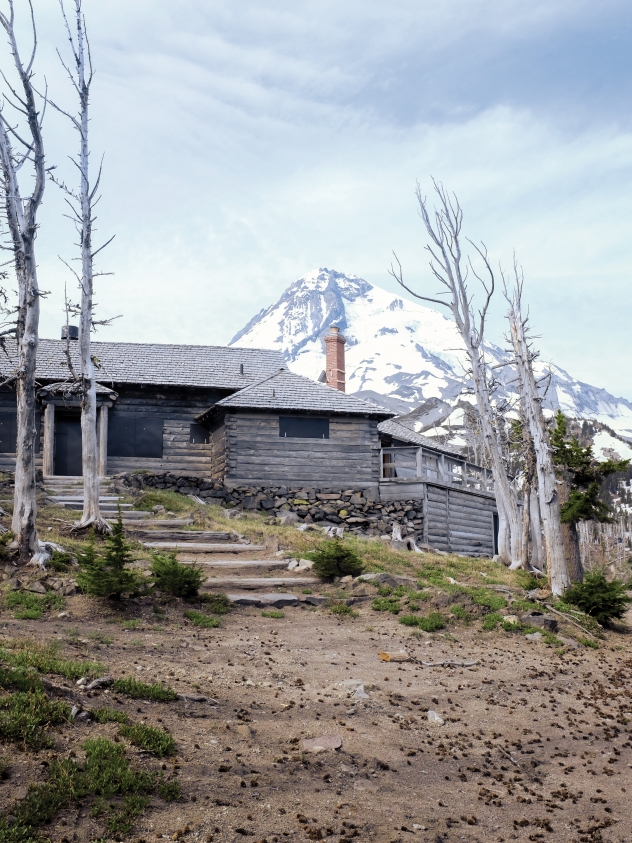
Photo by Cheston Knapp
WE FOOTSLOG THROUGH the underbrush and I get to daydreaming about Eliot, grinding away deep on the mountain, eroding it as a fateful secret does a family. Back in the Pleistocene, the Ice Age, Mount Hood was covered by an ice cap. It would’ve looked like a vanilla meringue cookie then, not an Oreo Blizzard from Dairy Queen. But about 10,000 years ago, at the onset of the Holocene, the Earth started to warm, and the retreating ice broke up into smaller glaciers, which then grew and shrank in response to the natural modulation of that age’s climate.
I can get dizzily agoraphobic thinking about time on this scale, about the phenomenal changes the Earth has already undergone, the epic stories that its landscapes tell. I imagine a fantastic timelapse taken of the glaciers as they waxed and waned would look something like the Earth breathing. Inhale, exhale. Systole, diastole. From 1300 to 1900 A.D., this part of the Earth went through a cooling period known as the Little Ice Age and the glaciers beefed up as a result. But now, thanks to the unnatural climate change humans have caused, Hood has lost more than thirty percent of its glacier cover in the last hundred years, a startling rate of recession. The temporal asymmetry at work here accounts for the heartbreak I feel—how long they take to form, how quickly they’re retreating. That Eliot is receding at a faster rate than it’s flowing downhill puts me in mind of someone falling off a cliff, trying to grasp the person who dropped him.
We come around a corner and find Cloud Cap perched above us. It looks anomalous and mythic and somehow allegorical, like a way station out of Pilgrim’s Progress. Our last stop before we push on to The Delectable Mountain. Built back in 1889 as a tony vacation spot, Cloud Cap gives off a distinctly Western vibe. You can easily picture a Conestoga wagon parked out front and wool-clad visitors rocking on the porch, idly chatting and occasionally pinging a spittoon. Cully unlocks the door and busies himself with the windows, propping open the heavy metal plates that guard them.
After a quick tour of the place, we unload the gear we won’t need today, eat an early lunch, and begin our final ascent. We head into thicker woods, where the grade is steep enough and the snow thick enough to reward the use of microspikes. Every so often Aidan needs help freeing his sled from a grabby branch.
“We’re officially off-trail,” Cully says. A small wave of dread flutters over me as my mind finishes his thought with, “And they were never heard from again.”
WE DEBOUCHE ABOVE the pines and find ourselves face to face with Eliot, a giant cape of ice and snow thrown over the shoulder of Hood. Seeing him for the first time like this sounds some mystic chord deep inside me. It’s like meeting an ancient God or an archetype. Horizontal time has gone vertical here, you can feel it, and it’s almost overwhelming—listen close enough and I’m sure I’d pick up the faint echoes of the Hallelujah Chorus.
Kiya’s excitement is palpable as she points out crevasses up above us, in the center of the mountain. They’re like stretch marks on the ice and a sign that Eliot’s still flowing. And sure enough, in this vibrant midday light, I spot flecks of brilliant blue glacier ice—its dense crystals absorb all the colors of the spectrum except blue. It’s breathtaking. I’ve learned to distrust my eyes and am curious where Eliot hides under the snow and rocks I see down below.
“How would you know we’re on a moraine if you could only look at your feet?” Kiya asks the group, not one to miss a teachable moment.
“Unsorted rocks of varying size,” Parker answers, confidently. “And all the till.”
“Totally,” Kiya says.
To get down to the glacier we have to descend about two hundred feet of the moraine. It’s astonishing to think that this valley was once domed with ice—you can see it in pictures from the turn of the last century, when Cloud Cap was built. And again I’m convinced that our psyches weren’t built to handle the pressures of climate change; I know mine has been deforming under them for years.
“There are day ruiners, month ruiners, year ruiners, and life ruiners,” Cully says, referring to the size of the boulders that sit precariously atop the loose till. “So let’s stagger the descent and always keep an eye above you. When you get down there, move out of the fall zone as quick as you can.”
Rocks of every order of ruination are scattered all along the base of the moraine, as much as thirty yards out. Once clear of that hazardous area, we find a place in the center of the mountain and Kiya starts instructing the students with the aplomb of a movie director. Parker begins calibrating the radar machine, Hannah takes the water sensors and heads down to the snout of the glacier, where the meltwater emerges, and Aidan fiddles with the GPS sensors. Kiya unfolds an ungainly probe, over nine feet long, and starts measuring the depth of the snow on the surface of the glacier.
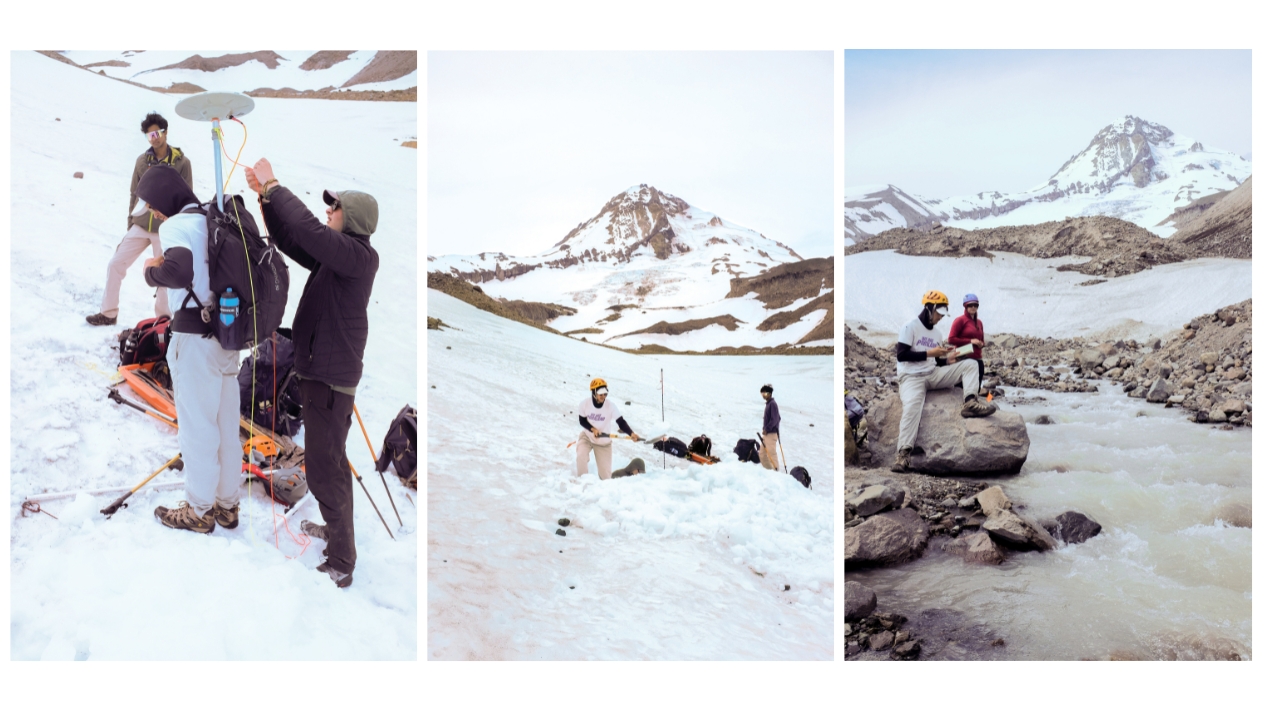
Photos by Cheston Knapp
It’s hard to overstate how literally awesome Hood looks from here, this close. It’s a giant cresting wave of rock, threatening to break on us. The lonely sound of rockfall occasionally fills the canyon—it’s a chilling sound, like the scuttling of some mammoth insect, and it takes all of me not to think “avalanche.”
“Be sure to keep detailed notes,” Kiya says. “Record the time and place of your measurements so we can refer back to them later.”
I move among the groups, trying to get a feel for how each person’s research will proceed. Once calibrated correctly, the radar machine will send a signal down into the ice and bounce back, giving a reading of how much snow sits atop Eliot and a rough outline of his base. To study the debris-layer, Parker will later don a giant GPS backpack that the group nicknamed The Droid, and he and Aidan will dig through the rock and sediment to determine the thickness of the debris-cover, which I learn serves as protective insulation for the ice beneath it, armor of sorts. And when they’re up here next week, they’ll dig a hole almost nine feet deep to measure subtle layers within the snow called ice lenses.
I trudge down to where Hannah is stringing up the first of the sensors and submerging them in the water. They measure its temperature and pressure and will show how deep the stream is. The rendering of the watershed she showed me last week pops to mind—it all begins here, where this greenish-blue meltwater has already formed a fast-flowing creek. She also does an orange-peel test, dropping bits of rind into the stream and recording how fast it travels between two points, which gives an idea of the volume of water coming off Eliot. At some point Kiya will find a suitable home for the bespoke GoPro she designed, which she’ll train on the summit in order to track the snow’s melting over the course of the summer.
“Sometimes I feel like I’m spying on nature,” she says, playfully summing up the work she does.
The team is just at the beginning of their study. Over the coming days they’ll gather data that they’ll spend months analyzing back in the computer lab, condensing it into a paper they aim to publish. For now I can entertain the vague hope that they won’t discover what they will: that Eliot is losing thirty-eight percent more of its surface area per year than when it was last measured back in 2007. I can imagine that the news might even be good.
As they go about their work, I post up on a rock and busy myself with my own field notes. I’m trying to process everything I’ve seen and heard today, to get my mind around this alien and otherworldly landscape. It’s moony and unscientific, but Eliot exerts a mysterious magnetism on me as I write. The fact that this ancient being existed before language puts me in a prayerful mood. I can almost feel him moving down there, a kind of spiritual presence, part of some deeper or different order of reality. A sacramental reality. As if to confirm this suspicion, a mountain bluebird buzzes by me. A darting tuft of electric blue, the very blue of glacier ice. Against the stark-white snow, it seems an ambassador from this other realm. I track him for just a couple seconds and then he’s gone, like a shooting star or holy vision. I swell with gratitude. How fortunate I am to have been here to see this ridiculous, unlikely creature. Grace, I think, an undeserved gift—it’s always humbling. Sitting here atop this mountain, I feel something likewise about Eliot. I’m just surpassingly grateful to have seen him while he’s still alive.
CHESTON KNAPP is Portland magazine’s senior writer and associate editor.
More Stories
Learn from UP's Glaciologists Atop Mt. Hood
Like most of the world's glaciers, the largest one on Mount Hood is shrinking. Researchers from UP are trying to figure out how fast.
- Video by Chris Brecht